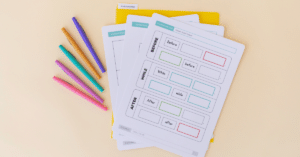Whew! There’s a lot to dig through when it comes to vocabulary intervention.
Where in the world do we start?
Last week, we dove into a framework, but you might still feel a little overwhelmed.
Let’s simplify things, shall we?
I’m writing about four key strategies that I think you need to know about. I’ll share a few resources to help you get started with each strategy.
My wish for you? Pick one strategy to focus on. Implement it for a few weeks and see how it goes! If you feel like you’re rocking that strategy (or if it just isn’t working for you), then come back and grab another strategy!
Strategy 1: Use Student-Friendly Definitions
Students with special needs often struggle to learn words indirectly and benefit from direct teaching of new vocabulary targets (Pence & Justice, 2016).
Don’t use definitions that students don’t understand. Pence and & Justice (2016) indicate that we may get more bang for our buck if we directly teach the definitions (rather than having students infer the meaning).
Recommended Resource #1: This dictionary is incredibly helpful when coming up with student-friendly definitions! We may still need to adjust the definition based on the student’s level and prior knowledge, but it sure is a great start!
Strategy 2: Create Opportunities for Multiple Repetitions
The average child needs 15 meaningful exposures for a word to become automatic (Marzano, 2004). Children with language impairment need more exposures (Pence & Justice, 2016).
Don’t expect your students to master a new word after a few exposures.
Recommended Resource #2: Check out last week’s blog post.
Strategy 3: Select Targets Strategically
If we are picking the “right” targets, then we’ll be able to get more bang for our buck!
Don’t pick targets just because they’re convenient (or they happen to be included in a deck of cards). Have a reason for the words you select!
Beck et al. (2013) includes four helpful criteria in their book, Bringing Words to Life (affiliate link).
1. Select words for direct instruction.
2. Select words that are unfamiliar.
3. Select words that are not too difficult to explain.
4. Select words that could easily be used in spoken language in a number of contexts. (Consider literacy-based and curriculum-based therapy targets!)
Recommended Resource #3: This article includes great suggestions for kindergarten students!
Strategy 4: Foster Engagement
Encouraging students to play with words creates an interest in knowing more about them (e.g., word consciousness) which is essential to vocabulary growth (Stahl, 1999).
Don’t let learning vocabulary be boring!
Recommended Resource #4: This blog post includes four ideas to keep your students engaged!
Video Version!
Want More Tips and Resources?
Enter your name and email below to follow this series! We’ll send you a weekly email (and a bonus resource) to help you implement these vocabulary strategies with your caseload!s!




your link for the framework from last week keep bringing me back to this page
thanks for the other resources – those links are working 🙂
Thanks for letting me know! I will fix that!